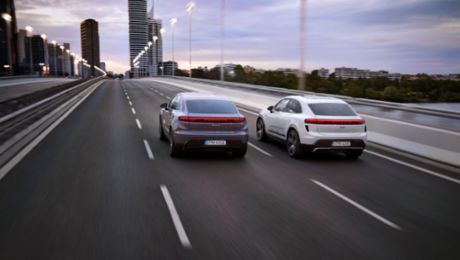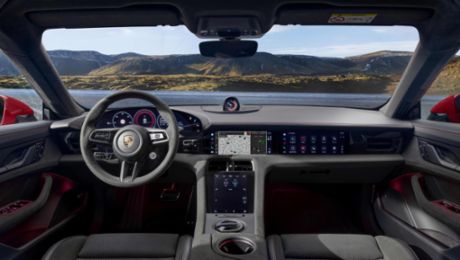The innovative drive architecture of the Macan, which is based on the Premium Platform Electric (PPE), is designed for sustained performance and high efficiency. The 800-volt technology, powerful electric motors and sophisticated battery and charging management ensure impressive, repeatable driving performance with combined WLTP ranges of up to 641 km.
Depending on the model, the Macan is equipped with different powertrain combinations. Permanent magnet synchronous motors (PSM) are used exclusively, as they enable high efficiency and consistent reproducibility of the power output. All electric motors in the new Macan use windings made of rectangular copper wire to maximise the amount of copper filling the grooves in the stator. The windings are arranged either in a U-shape, like a hairpin, and welded on one side, or – like in the performance rear-axle motor of the Macan Turbo – as an I-pin welded on both sides.
The electric motor on the front axles of the all-wheel drive models has a diameter of 210 mm and an active length of 100 mm. It alone produces up to 175 kW. The models differ at the rear axle. The Macan and Macan 4 utilise a more compact design with an inverter, which ensures a particularly efficient and lightweight powertrain. The electric motor has a diameter of 210 mm and an active length of 200 mm and boasts an output of up to 265 kW (360 PS). The rear motor of the Macan 4S has a diameter of 230 mm and an active length of 150 mm. The Macan Turbo has a larger and more powerful drive unit on the rear axle with a diameter of 230 mm and an active length of 210 mm. The electric motor with a maximum output of 470 kW (639 PS) provides remarkably high torque, sustained levels of continuous high output, and outstanding power density – as well as a maximum efficiency of up to 97 per cent.
System output of up to 470 kW, and 1,130 Nm of torque
All Macan models meet performance demands. An overview of the overboost performance values when using the launch control:
- Macan: 265 kW (360 PS) and 563 Nm
- Macan 4: 300 kW (408 PS) and 650 Nm
- Macan 4S: 380 kW (516 PS) and 820 Nm
- Macan Turbo: 470 kW (639 PS) and 1,130 Nm.
Power is transmitted to the wheels via a single-speed transmission, designed as a parallel-axis three-shaft gearbox. On the front axle, the all-wheel-drive models use a gearbox with a ratio of 9.2. A lightweight spur-gear differential is used here to keep the gearbox compact. The models differ at the rear axle. The Macan and Macan 4 use a gearbox with a ratio of 9.8, while the Macan 4S uses a 10.0 ratio. The Macan Turbo features a gearbox with a ratio of 9.0, which is designed to withstand larger forces. A special feature here is the additional integration of an electronically controlled rear-axle differential lock for Porsche Torque Vectoring Plus.
Power electronics with silicon carbide semiconductors in the Turbo
The pulse inverter comprises the power electronics that convert the direct current from the battery into three-phase alternating current for the electric motors. The main distinguishing features are the current-carrying capacity and the semiconductor material. The pulse inverter used on the front axle of the Macan 4, Macan 4S and Macan Turbo utilises silicon as the semiconductor material. It conducts a maximum of 350 amps to the electric motor. In the pulse inverter on the rear axle of all Macan models, the highly efficient semiconductor material silicon carbide (SiC) is used for the benefit of higher efficiency. This significantly reduces switching losses in the pulse inverter and enables higher switching frequencies. The rear-axle pulse inverter in the Macan and Macan 4 conducts a maximum of 480 amps; in the Macan 4S this is 600 amps and in the Macan Turbo it achieves an impressive 900 amps.
System management also plays an important role in the overall efficiency of a vehicle. Depending on the selected driving mode and the driving situation, the drive torque of the all-wheel-drive models of the new Macan is distributed fully variably between the front and rear axles. Under stable, moderate driving conditions, the drive torque comes exclusively from the rear-axle drive unit. In this case, the front axle is driven passively and can immediately provide drive torque again if required. This fully exploits the efficiency potential of the SiC pulse inverter while retaining the driving stability of an all-wheel drive vehicle.
Up to 240 kW recuperation capacity plus coasting ability
Recuperation offers further efficiency benefits. Recuperation at up to 240 kW (Macan: 200 kW), depending on the level of brake pedal actuation as well as the temperature and state of charge of the battery (SoC), among other factors. This corresponds to a deceleration of around 4.3 m/s², which is about 40 per cent of the maximum braking power. This means that up to 98 per cent of the total braking energy can be recovered, under everyday driving conditions. If the desired deceleration is greater than the power that can be absorbed via recuperation, the hydraulic brakes are applied. The fine balancing of the braking force via the blending function is imperceptible to the driver.
In keeping with the Porsche philosophy, the Macan can also coast. If the driver eases off the accelerator pedal but does not actively brake, the drive unit is switched off or, at higher speeds, switched to ‘zero-torque mode’. This decreases the dissipation of kinetic energy and the car glides as far as possible without energy input. Alternatively, the driver can activate energy recuperation via the PCM. Recuperation then takes place with a moderate deceleration of 0.6 m/s². This roughly equates to the deceleration that typically results from engine drag torque, commonly referred to as the engine braking, in conventional drive systems.
All in all, the efficient high-voltage and drive systems of the new Macan models result in long ranges, despite the characteristic sports car performance. Combined WLTP range:
- Macan: up to 641 km
- Macan 4: up to 612 km
- Macan 4S: up to 606 km
- Macan Turbo: up to 590 km.
Exhilarating sound experience: Porsche Electric Sport Sound
The high-performance driving experience of the new Macan models can be emphasised with a Porsche Electric Sport Sound specially created for the SUV. An intelligent control algorithm provides the appropriate emotive sound to suit the driving situation and the torque and speed of the electric motors. The Macan-specific sound is produced via the entire entertainment sound system, as well as through two dedicated exterior speakers.


